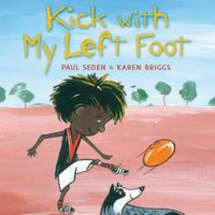Kick with my left foot by Paul Seden and Karen Briggs

Allen & Unwin, 2014. ISBN 978174331344.
'I pull the sock on my left foot
I pull the sock on my right foot
I lace up the boot on my left foot
I lace up the boot on my right foot . . .
It's time for footy!'
This is a charming story of a little boy who loves his footy and can
do everything well with his right and left hands, except for when it
comes to kicking. When the tries to kick with his right foot, the
results are less than great. But kicking with his left foot is a
totally different matter! In a place where footy is an integral part
of life, being able to kick well is an important skill and there is
great excitement when his left foot kicking is the clincher.
Accompanied by illustrations that depict the emotions of both the
boy and his dog perfectly, this story really appealed to the younger
readers in my family who are struggling with left and right, as well
as with throwing and kicking. In fact, Miss 3 and a half immediately
went outside and practised with both feet to see which one worked
best for her. Many times the results were those shown in the
pictures but with practice she began to improve, and now has also
sorted out that left/right confusion.
The book is one of the Emerging Indigenous Picture Book Mentoring
Project a partnership between the Little Big Book Club and Allen
& Unwin in which six previously unpublished Indigenous writers
and illustrators will have their work showcased in four picture
books during 2014. Each creator has been partnered with a renowned
mentor in children's publishing including Nadia Wheatley, Ken
Searle, Nick Bland, Ann James, Bronwyn Bancroft, Boori Monty Pryor
and Ali Cobby Eckermann to share ideas, techniques and inspiration
for their first published work. The project has been funded by the
federal government through the Australia Council and it means that
not only will our cohort of children's writers be enriched but our
students will have access to authentic texts that will work towards
the understanding and harmony between our cultures that is at the
heart of so many of the Australian Curriculum outcomes. Even though
it is written for an early childhood audience, there is a lot that
offers scope for comparing and contrasting lifestyles and landscapes
that would enable younger students to continue the development of
their critical thinking skills. Even determining which code of
football is being played requires observation and justification!
Barbara Braxton